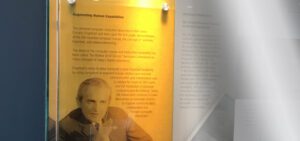By Prasad Akella, Founder and CEO, Drishti
The next time you come to a meeting at SRI International’s headquarters, arrive early.
Linger in front of the glass-enclosed exhibit that lines the lobby’s left wall. It contains descriptions and artifacts from SRI’s storied history, arranged thematically from the 40’s to today.

You’ll learn about everything from radar technology to medical devices to Siri. And then, when you finally reach the gold-colored plaque at the far left of the exhibit, you will have the context to appreciate the common theme that unites everything else you just read.
Nearly two years ago, I paused in front of this plaque. It was my first day as an SRI entrepreneur-in-residence. I like to believe that the stirring I felt that day wasn’t just first day jitters, but something deeper: a connection with history.
I didn’t know it at the time, but the SRI spin-out company that I lead is directly connected to the narrative that unites 70 years of SRI history. Three simple words: “augmenting human capabilities.”
Augmenting human capabilities… inside the factory
According to Boston Consulting Group—and validated by the hundreds of conversations I’ve had with manufacturers over the last two years—only about 10 percent of tasks today are performed by robots. The vast majority of value created inside a factory is done by humans
Most people in the industry assume this needs to change. There’s an assumption that humans have reached their peak: that productivity and quality can’t go any higher unless robots assume the key roles. For that reason, the vast majority of manufacturing innovation is focused on improving robots or machines to displace humans. (I speak from experience: this was the thesis that even I subscribed to early in my career.)
But SRI’s legacy is about augmenting people, not displacing them. That’s why I initially came to SRI with an idea for a different approach. Call it a judo move on robots: taking the technologies that have made them so effective and transforming them to help people instead.
Peter Marcotullio, vice president, Commercial R&D and Manish Kothari, Ph.D., president, SRI Ventures heard me out, joined in the brainstorming, and enthusiastically jumped into the arduous task of moving it from an idea to a company. As an SRI entrepreneur-in-residence (where I had the pleasure of working alongside this world-class team that included Laurie Menoud and Bhaskar Ramamurthy, Ph.D.), I worked to prove the concept, and then formally spin a company out of SRI.
Most recently, Drishti (Sanskrit for “vision”) announced that we have raised $10 million in Series A funding, with Emergence Capital leading the round. Andreessen Horowitz and Benhamou Global Ventures, which invested in Drishti’s 2017 seed round, also participated.
Advancing AI and computer vision to benefit people
“The industry has been very focused on robots,” says Rakesh “Teddy” Kumar, Ph.D., vice president, Information and Computing Sciences and director of SRI’s Center for Vision Technologies. I worked with Teddy and his colleagues, including Bill Mark, Ph.D., president of Information and Computing Sciences and researchers Ben Southall, Kilho Son, and Ajay Divakaran to prototype the early Drishti system. “Robots are where all the hype is. But Drishti is focused on augmenting human performance. This will make people less prone to errors, more productive, and more confident that their tasks have been done well. And it will lower manufacturing costs.”
Drishti’s technology uses what we believe to be the world’s first commercial application of action recognition to digitize human activities—continuously, non-intrusively and at scale. This creates a dataset that is used to break through the ceilings that are perceived to limit human capabilities in the factory.
Our thesis is that humans—backed by technology—are on the cusp of great potential leaps in their capabilities. Far from displacing people, we believe that humans are about to get far more valuable.
You can learn more about Drishti and the problem we solve on our website. What I’d like to spotlight is our company’s mission statement: “to extend human potential in an increasingly automated world.”
This mission statement arose organically from the passionate discussions among the members of the Drishti team. We weren’t thinking about SRI when we wrote it. Yet I was stunned when I recently returned to SRI and realized just how closely our mission mirrored the statement from the golden plaque in the SRI lobby.
Proud to extend SRI’s legacy into the factory
“If you look at what SRI is most known for, starting with the very first computer mouse, it’s about augmenting people,” explains Manish Kothari, Ph.D., president, SRI Ventures. “Intuitive Surgical, for example, doesn’t replace surgeons, it augments them. Siri was our effort to make people smarter than they are on their own. Seismic makes soft robotic clothing that helps people who are losing their mobility. Our core values are to make society ‘safer, healthier, and more productive’. And Drishti is continuing this throughline.”
Fifty years ago, Douglas Engelbart made humans more capable using information technology, and immortalized his—and SRI’s—place in history.
Today, Drishti is honored to continue this legacy by making humans more capable—this time, using AI and computer vision inside the factory. Prasad Akella is Founder & CEO of Drishti, an SRI International spin-out, and a former SRI Entrepreneur-in-Residence. Learn more at Drishti.com .


